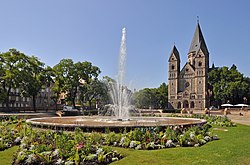Metz
Metz is a city in France, the prefecture of the Grand Est region and the Moselle department.
|
Metz | ||

| ||
| Clockwise from top: overview of city center (with Cathedral of Saint Stephen), Imperial Quarter, Temple Neuf, Germans' Gate, Opéra-Théâtre (place de la Comédie) | ||
|

| |
| Administration | ||
|---|---|---|
| Country | France | |
| Region | Lorraine | |
| Department | Moselle | |
| Arrondissement | Metz | |
| Canton | 3 cantons | |
| Intercommunality | Metz Métropole | |
| Mayor | François Grosdidier[1] (2020–2026) | |
| Statistics | ||
| Elevation | 162–256 m (531–840 ft) | |
| Land area1 | 41.94 km2 (16.19 sq mi) | |
| INSEE/Postal code | 57463/ 57000 | |
| Website | Metz Ville | |
| 1 French Land Register data, which excludes lakes, ponds, glaciers > 1 km² (0.386 sq mi or 247 acres) and river estuaries. | ||
History
There was once a city in Roman times, called Divodurum. It was the capital of a Celtic tribe called Mediomatrici. They were called the "Mettis" for short, which is where the name "Metz" comes from. The Romans controlled this city for a long time as an important center in Gallia, but it was captured by Attila the Hun in 451. It was shortly after taken over by the Franks.
Metz remained a very important city, and as the borders changed over the years, it became the capital of Austrasia (from 561 to 751) and of Lotharingia (from 843 to 925), before becoming part of the Holy Roman Empire (from 925). The city was handed to King Henry II of France in 1552. In 1633, it became the capital of a French province called the "Three Bishoprics". The Prussians captured the town in 1870 and Metz once again became part of Germany, until 1918 when it was won back by France. The Germans captured it once more in1940 but France regained it in 1944.
Monuments
In this city, there are a lot of monuments like :
- The Opéra-théâtre, XVIII°s, the oldest theatre of France, it is on an island.
- The Place Saint-Louis, XIV°s, it is triangular, with arcaded houses typical of the architecture of Metz.
- The Cathédrale Saint-Etienne (St. Stephen's Cathedral), X°s, gothic style, with 6000m² of stained glass.
- The Jardin botanique de Metz (Botanical garden of Metz), 1866, there are 490.000 flowers every years and there is a greenhouse.
Climate
Metz has an oceanic climate (Cfb in the Koeppen climate classification).
Education
Twin towns – sister cities
Metz is twinned with:
|
|
Metz Media
Henry II of France entering Metz in 1552, putting an end to the Republic of Metz.
The Hôtel de Ville on the Place d'Armes
Water games in the Islands District
The Germans' Gate from the 13th century, one of the last medieval bridge castles found in France. Today, an exhibition hall
References
- ↑ "Répertoire national des élus: les maires". data.gouv.fr, Plateforme ouverte des données publiques françaises (in français). 2 December 2020. Retrieved 11 December 2020.
| Wikimedia Commons has media related to Lua error in Module:Commons_link at line 62: attempt to index field 'wikibase' (a nil value).. |
| Wikivoyage has a travel guide about: Metz |











